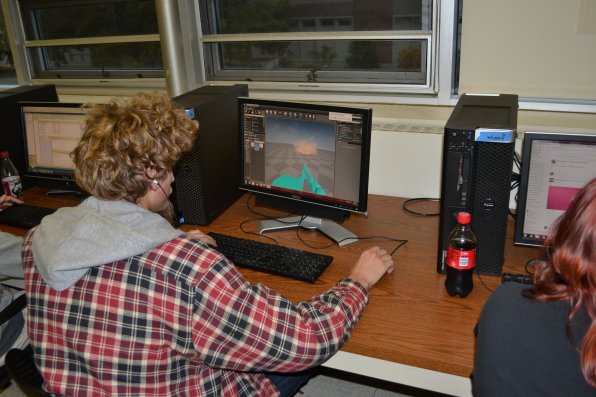Things in the gaming world have come a long way since the days of Pitfall and Pac-Man.
Back in the day, video games were simple. The controller had a directional pad with a few simple buttons. The characters moved across the screen, from left to right and right to left if you were lucky, with some even having the ability to jump – we’re talking cutting edge stuff here, people.
Today’s realistic adventures like Halo, Call of Duty and Destiny make you feel like part of the game, but believe us when we tell you this – it’s just a game. The controllers now have more buttons and joysticks than most people know what to do with. You can even play against people on the other side of the world. Talk about confusing – that is unless you’re a real gamer like the students in NHTI’s Animation and Graphic Game Programming degree.
“Somewhere around 2000, the industry really matured,” said professor Greg Walek.
As part of the program, students learn all the necessary tools needed to enter the gaming industry after two years, or like many NHTI degrees, be transferable to a four-year institution to further their education.
With professors like Walek on staff, the students are learning from someone who has been a part of the gaming world. Like his NHTI pupils, Walek also pursued a degree that would put him into the industry before turning to teaching in 2007. He worked for companies like Activision and Ravensoft and helped put out T Mobile games Catwoman and Batman Begins, as well as MARVEL: Ultimate Alliance.
Now you might think that a degree in game programming would mean a lot of playing video games, but that’s far from the case. Actually, they play very little during class, and there’s good reason for that.
“They’re playing games as it is. They don’t need to play in this class,” Walek said. “We typically don’t have time. If we’re playing a game, we’re doing it to break down the game.”
Instead, the students are using the most up to date programs, including ones that are used throughout the professional ranks of game developers, like Unreal Engine 4.
“For me personally, I just love creating game environments,” student Brian Lizotte said. “And now when I’m playing a video game I’m looking at what codes I’m going through.”
Like most college programs, the first year is used to provide a solid foundation, so students take introductory courses for game design and creation, content development, programming with C++ and 2-D and 3-D game development. It’s in year two where the fun really begins – and the application process takes shape.
“They’re doing some sort of programming in week one,” Walek said. “We only have two years with them, so we get them up to speed with as many techniques that they can transfer or use to get into the industry.”
One project Walek gives his second year students in his 3-D game engine application development course boils down to a couple key phrases. This semester, one group got fire, another got two minutes to survive and a third got battle and tanks. The students must use those phrases as a jumping off point to begin programming a game prototype.
“They come up with the concept themselves based on the guidelines,” Walek said.
And once you watch what these students have to do to create just the simplest of elements in a game, it will give you a new appreciation the next time you pick up a controller. They work together in teams to develop the prototype and eventually toward turning that prototype into a real life game with an objective.
“They are making their own games right now,” Walek said. “One of the philosophies we have in the program is getting them through as many programming cycles as possible.”
Said teamwork is a huge piece of the program. Walek encourages his students to not only work with their group, but anyone else in the class because they all share the same passion.
“I like making games, I like playing games,” said student Jessie Wasner, the only female in the class. “It’s kind of been a thing for a while where I’ve been interested in games.”
At the end of this year, everyone can get a good look at what’s been developed at the Show of Games. It’s not a competition, per say, but of course there are bragging rights on the line.
“It’s a wide range of the best of the best,” Walek said.
So if you pop by the lab on weekends, nights and holidays, the lights are usually on. But don’t worry, they have permission.
“We actually give them a letter to show security,” Walek said.
And if you’re free Nov. 21-23, you might want to head on over to NHTI for the yearly Game Jam. It’s 48 hours, beginning Friday at 5 p.m., of some intense game building collaboration.




















